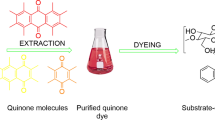Abstract
A gas chromatographic–mass spectrometric procedure for the analysis of dyes from plant extracts was optimized and applied for the detection of components in extracts from 12 dyeing plants native from all over the world. The main marker molecules in each of the dyestuffs, as well as accessory compounds, were successfully separated and identified by means of their electron impact mass spectra, thus demonstrating that a single GC–MS procedure can be conveniently applied to the detection of natural dyes such as flavonoids, neoflavonoids, anthraquinones and tannins. Other constituents of plant extracts, such as organic acids, oils and sugars, that hydrolyse during the extraction process, were also detected and recognized in the same chromatographic run. The GC–MS method was tested on woollen references dyed according to traditional recipes, and on historical wool samples taken from a tapestry of the sixteenth century, and the main dyestuffs used for colouring could be traced even with the low amounts usually available with the archaeometric samples. Besides some limitations, that are addressed, the results show that the GC analysis is a useful tool for quick assessment and control of natural extracts and the application of the technique for the characterization of dyes in historical textiles, in addition or in place of the more widely used procedures that employ liquid chromatography, is encouraged.









Similar content being viewed by others
References
Cardon D (2007) Natural dyes: sources, tradition. Technology and science. Archetype, London ISBN 190498200x
Hofenk de Graaff JH (2004) The colourful past. Archetype, London ISBN 1873132131
Brunello F (1973) The art of dyeing in the history of mankind. Neri Pozza, Vicenza
Bechtold T, Mussak R (2009) Handbook of natural colourants. John Wiley, Chichester
Rosenberg E (2008) Anal Bioanal Chem 391:33
Degano I, Ribechini E, Modugno F, Colombini MP (2009) Appl Spectrosc Rev 44:363
Molnàr-Perl I, Füzfai ZS (2005) J Chromatogr A 1073:201
Tekel J, Daeseleire E, Heeremans A, van Peteghem C (1999) J Agric Food Chem 47:3489
Henriksen LM, Kjøsen H (1983) J Chromatogr 258:252
Boldizsár I, Szucs Z, Fuzfai ZS, Molnar-Perl I (2006) J Chromatogr A 1133:259
Colombini MP, Andreotti A, Baraldi C, Degano I, Łucejko JJ (2007) Microchem J 85:174
Tutin TG, Heywood VH, Burges NA, Moore DM, Valentine DH, Walters SM, Webb DA (1980) Flora Europaea, vol 5. Cambridge University Press, Cambridge, UK, p 476
Leitner P, Fitz-Binder C, Mahmud-Ali A, Bechtold T (2012) Dyes Pigments 93:1416
Derksen GCH, Niederlander HAG, van Beek TA (2002) J Chromatogr A 978:119
Ellis B. E., (1988) Nat. Prod. Rep. 5: 581 (ex 18 tab 1 )
van den Berg AJJ, Radema MH, Labadie RP (1988) Plant Sci 56:123
van den Berg AJJ, Labadie RP (1984) Planta Med 50:449
Conedera M, Krebs P, Tinner W, Pradella M, Torrioni D (2004) Veg Hist Archaeobot 13:161
Shen D, Wu Q, Wang M, Yang Y, Lavoie EJ, Simon JE (2006) J Agric Food Chem 54:3219
Zhaobang S. (1995) Production and standards for chemical non-wood forest products in China. CIFOR Occasional Paper No. 6. ISSN 0854-9818
Muhammad S, Khan BA, Akhtar N, Mahmood T, Rasul A, Hussain I, Khan H, Badshah A (2012) J. Med Plants Res 6:4772
Chattopadhyay RR, Bhattacharyya SK (2007) Pharmacogn Rev 23:145
Rathinamoorthy R, Thilagavathi G (2014) Int J Pharm Tech Res 6:97
Blau K, Halket J (1993) Handbook of derivatives for chromatography. Wiley and Sons, Chichester ISBN 047192699x
Zuo Y, Wang C, Lin Y, Guoa J, Deng Y (2008) J Chromatogr A 1200:43
http://www.fondoambiente.it. Accessed 1 Sep 2014
de Rijke E, Out P, Niessen WMA, Ariese F, Gooijer C, Brinkman UATh (2006) J Chromatogr A 1112:31
Kennedy JF, Robertson SM (1978) Carbohydr Res 67:1
Bleton J, Mejanelle P, Sansoulet J, Goursaud S, Tchapla A (1996) J Chromatogr A 720:27
Hulme AN, McNab H, Peggie DA, Quye A (2005) Phytochem J 66:2766
Temsiririrkkul R, Punsrirat J, Ruangwises N, Wongkrajang Y, Nakornchai S (2007) Planta Med 73:901
Amakura Y, Okada M, Tsuji S, Tonogai Y (2000) J Chromatogr A 896:87
Daniel EM, Krupnick AS, Heur YH, Blinzler JA, Nims RW, Stoner GD (1989) J. Food Comp Anal 2:338
Vekiari SA, Gordon MH, García-Macías P, Labrinea H. (2008) Food Chem 110:1007
Barbehenn RV, Jones CP, Karonen M, Pekka Salminen J (2006) J Chem Ecol 32:2235
Hakkinen SH, Karenlampi SO, Mykkanen HM, Heinonen IM, Torronen AR (2000) Eur Food Res Technol 212:75
Schofield P, Mbugua DM, Pell AN (2001) Anim Feed Sci Tech 91:21
Acknowledgments
Couleurs de Plantes, Rochefort (France) is gratefully acknowledged for the supply of plant extracts and the “Associazione Tintura Naturale Maria Elda Salice” for the reference woollen samples. This research was partially supported by the national project PRIN 2010–2011: Sustainability in Cultural Heritage: from diagnosis to the development of innovative systems for consolidation, cleaning and protection.
Author information
Authors and Affiliations
Corresponding author
Rights and permissions
About this article
Cite this article
Degani, L., Riedo, C., Gulmini, M. et al. From Plant Extracts to Historical Textiles: Characterization of Dyestuffs by GC–MS. Chromatographia 77, 1683–1696 (2014). https://doi.org/10.1007/s10337-014-2772-z
Received:
Revised:
Accepted:
Published:
Issue Date:
DOI: https://doi.org/10.1007/s10337-014-2772-z




